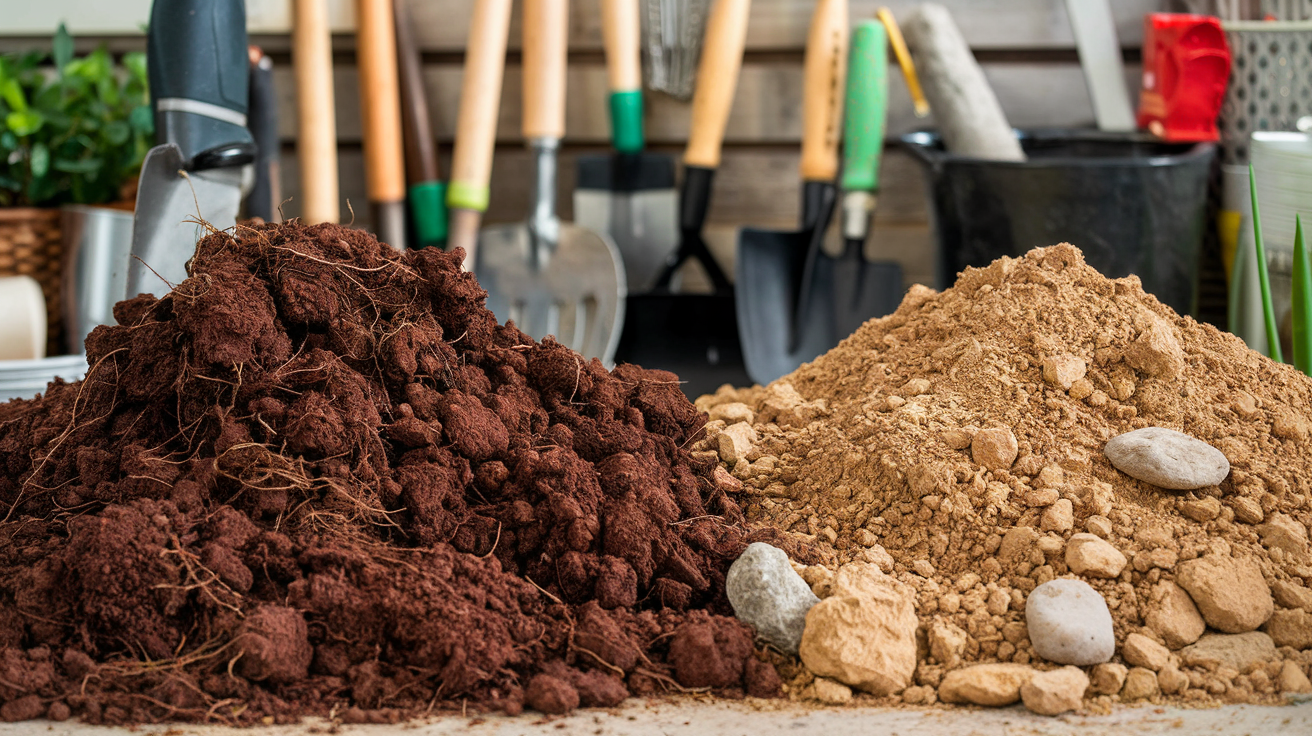When it comes to gardening and landscaping, understanding the difference between topsoil and fill dirt is crucial for achieving the best results. Rhys Garden has seen how choosing the right type of soil can make or break a project. In this guide, I’ll explain the key differences between topsoil and fill dirt, and how to determine which is best suited for your gardening or landscaping needs.
Understanding Soil Basics
Before we delve into the specifics of topsoil and fill dirt, it’s essential to understand what soil is and why it’s so important for plant growth.
What is Soil?
Soil is a complex mixture of organic matter, minerals, gases, liquids, and organisms that together support plant life. It’s not just dirt, but a living ecosystem that plays a crucial role in the health of your garden.
The Importance of Soil in Gardening
Healthy soil provides several key functions:
- Nutrient supply: It contains essential nutrients that plants need to grow.
- Water retention: Good soil holds water and releases it slowly to plant roots.
- Aeration: It allows air to circulate around plant roots.
- Microbial activity: Soil hosts beneficial microorganisms that support plant health.
What is Topsoil?
Topsoil is the uppermost layer of the earth’s surface, typically ranging from 2 to 8 inches deep. This is where most of the biological activity in soil occurs, making it crucial for plant growth.
Characteristics of Topsoil
- Rich in organic matter
- Dark in color due to decomposed plant material
- Teeming with microorganisms
- High in nutrients essential for plant growth
- Good water retention capabilities
Types of Topsoil
Topsoil can vary in composition and quality:
- Loam: A balanced mixture of sand, silt, and clay
- Sandy loam: Contains more sand, offering better drainage
- Clay loam: Higher in clay, retains more water and nutrients
Uses of Topsoil in Gardening
Topsoil is versatile and can be used for various gardening purposes:
- Creating new garden beds
- Improving existing soil
- Filling raised beds
- Top-dressing lawns
- Potting soil for container gardens
What is Fill Dirt?
Fill dirt, as the name suggests, is primarily used for filling in areas or creating a stable base. It’s composed of subsoil and lacks the organic matter and nutrient content of topsoil.
Characteristics of Fill Dirt
- Compacts easily
- Low in organic matter
- Poor in nutrients
- Often contains rocks and clay
- Lighter in color compared to topsoil
Types of Fill Dirt
Fill dirt can vary based on its composition:
- Sandy fill: Contains more sand, drains quickly
- Clay fill: High in clay content, retains water
- Crushed rock fill: Contains crushed stone or gravel
Uses of Fill Dirt in Landscaping
Fill dirt serves several purposes in landscaping and construction:
- Leveling uneven terrain
- Creating a stable base for structures
- Filling large holes or depressions
- Erosion control on slopes
- Building up low-lying areas
Topsoil vs Fill Dirt: Key Differences

Understanding the differences between topsoil and fill dirt is crucial for choosing the right material for your project. Let’s compare these two types of soil across various factors:
Composition
- Topsoil: Rich in organic matter, microorganisms, and nutrients
- Fill Dirt: Mostly inorganic material, low in nutrients and organic content
Texture
- Topsoil: Generally loose and crumbly
- Fill Dirt: Often compacted and dense
Color
- Topsoil: Dark brown or black due to organic matter content
- Fill Dirt: Lighter in color, often tan or reddish
Nutrient Content
- Topsoil: High in essential plant nutrients
- Fill Dirt: Low in nutrients, not suitable for plant growth without amendments
Water Retention
- Topsoil: Good water retention capabilities
- Fill Dirt: Poor water retention, often leading to drainage issues
Cost
- Topsoil: Generally more expensive due to its nutrient content and preparation
- Fill Dirt: Usually less expensive, as it requires less processing
Primary Uses
- Topsoil: Gardening, planting, improving soil quality
- Fill Dirt: Construction, leveling, creating a stable base
When to Use Topsoil
Topsoil is the go-to choice for most gardening and planting projects. Here are some scenarios where topsoil is the best option:
- Creating new garden beds
- Improving existing soil in your garden
- Filling raised beds for vegetable or flower gardens
- Top-dressing lawns to improve grass growth
- Container gardening
- Repairing bare or damaged patches in your lawn
Benefits of Using Topsoil
- Promotes healthy plant growth
- Improves soil structure and drainage
- Increases water retention in sandy soils
- Adds essential nutrients to your garden
- Supports beneficial microbial activity
Potential Drawbacks of Topsoil
- More expensive than fill dirt
- May introduce weed seeds if not properly sourced
- Can be too rich for some native plants that prefer poor soil
When to Use Fill Dirt
Fill dirt is best suited for projects where soil fertility is not a priority. Here are some situations where fill dirt is the appropriate choice:
- Leveling uneven ground
- Creating a stable base for patios, walkways, or driveways
- Filling large holes or depressions in your yard
- Building up low-lying areas to improve drainage
- Erosion control on slopes
- As a base layer under topsoil in raised beds
Benefits of Using Fill Dirt
- Provides structural stability
- Less expensive than topsoil
- Compacts well, creating a solid foundation
- Doesn’t break down over time like organic matter
- Suitable for large-scale filling projects
Potential Drawbacks of Fill Dirt
- Not suitable for plant growth without amendments
- Can lead to drainage issues if not properly managed
- May contain rocks or debris that need to be removed
- Can be difficult to work with due to its dense nature
How to Choose Between Topsoil and Fill Dirt
Selecting the right soil for your project depends on several factors:
- Project purpose: Are you planting or building?
- Soil quality: What’s the current state of your soil?
- Budget: How much are you willing to spend?
- Volume needed: Large projects might favor fill dirt for cost reasons
- Long-term plans: Consider future use of the area
Preparing Your Site for Topsoil or Fill Dirt
Proper site preparation is crucial regardless of whether you’re using topsoil or fill dirt:
- Clear the area of debris, rocks, and weeds
- Grade the site to ensure proper drainage
- Compact the existing soil if using fill dirt as a base
- Consider adding a layer of landscape fabric to prevent weed growth
- Plan for proper depth based on your project needs
Mixing Topsoil and Fill Dirt: When and How
In some cases, combining topsoil and fill dirt can provide the best of both worlds:
- Use fill dirt as a base layer for raised beds, then top with topsoil
- Mix topsoil with fill dirt to improve soil quality while maintaining structure
- Layer fill dirt and topsoil to create berms or raised landscape features
Tips for Mixing Soils
- Aim for a ratio of about 1 part topsoil to 3 parts fill dirt for general landscaping
- Use a tiller or shovel to thoroughly mix the soils
- Test the pH and nutrient levels of the mixed soil and amend as needed
Amending Fill Dirt for Plant Growth
If you need to use fill dirt in an area where you plan to grow plants, you’ll need to amend it:
- Add organic matter such as compost or well-rotted manure
- Incorporate slow-release fertilizers to improve nutrient content
- Add sand or gypsum to enhance drainage of clay-heavy fill dirt
- Consider adding beneficial microorganisms to jumpstart soil life
Sourcing Quality Topsoil and Fill Dirt
The quality of your soil can make or break your project. Here’s how to ensure you’re getting good soil:
- Buy from reputable suppliers
- Ask for soil test results
- Inspect the soil visually and by touch
- Consider having the soil tested independently
- Look for certifications or guarantees from the supplier
Red Flags When Buying Soil
- The presence of large debris or trash
- Strong, unpleasant odors
- Meager prices
- Lack of information about the soil’s origin or composition
Environmental Considerations
When choosing between topsoil and fill dirt, consider the environmental impact:
- Topsoil removal can damage ecosystems if not done sustainably
- Fill dirt may contain contaminants if sourced from industrial areas
- Transportation of soil contributes to carbon emissions
- Proper soil management can help sequester carbon and mitigate climate change
Case Studies: Topsoil vs Fill Dirt in Action
Case Study 1: Urban Garden Renovation
A community garden in a city faced poor soil quality. By importing quality topsoil and mixing it with the existing soil, they were able to create fertile beds that produced abundant vegetables.
Case Study 2: Landscape Leveling Project
A homeowner needed to level their sloping backyard. Using fill dirt as a base and topping it with a layer of topsoil, they created a flat, usable space that supported a lush lawn.
Frequently Asked Questions
Q1: Can I use topsoil for filling large holes?
A: While possible, it’s often more cost-effective to use fill dirt for large holes and top with a layer of topsoil for planting.
Q2: Is fill dirt completely devoid of nutrients?
A: Fill dirt typically has very low nutrient content, but it’s not completely sterile. However, it needs significant amendment to support healthy plant growth.
Q3: How deep should topsoil be for a vegetable garden?
A: For most vegetables, a minimum of 6-8 inches of good quality topsoil is recommended, with 12-18 inches being ideal for deep-rooted plants.
Q4: Can I make my own topsoil?
A: While you can improve soil quality through composting and amendments, creating true topsoil takes years of natural processes.
Q5: Is it necessary to remove grass before adding topsoil?
A: For best results, remove existing grass or till it into the soil before adding a new layer of topsoil.
Conclusion
Knowing the distinctions between topsoil and fill dirt can greatly impact the success of your gardening or landscaping efforts. By selecting the appropriate soil for your project, you ensure a strong foundation for plant growth and landscape stability. Whether you’re planting a garden or leveling land, understanding the unique qualities of topsoil and fill dirt will help you make informed decisions and achieve the best possible outcome for your outdoor space.

Related Posts
Best Soil for Indoor Plants: A Guide for Thriving Greenery
The Ultimate Guide to Sand Soil Mix for Leveling
Understanding and Using Soil Moisture Meter Charts